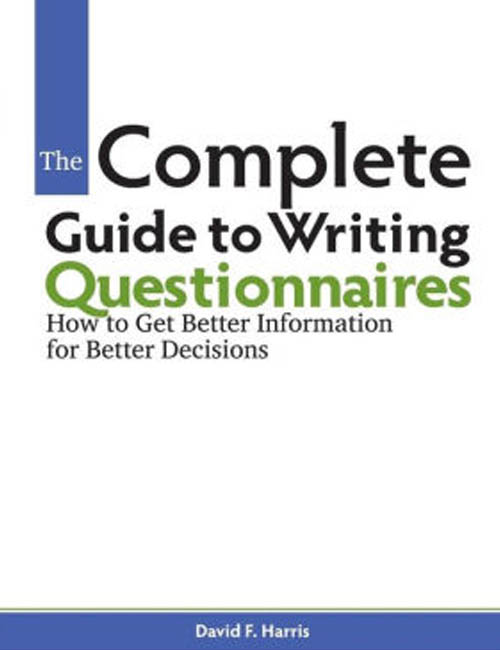Reviewed by Susan Fader, susanfader@faderfocus.com
Fader & Associates, Teaneck, NJ
The Complete Guide to Writing Questionnaires, by David F. Harris, is a very practical, engagingly written book that is filled with helpful suggestions for both the experienced and the novice questionnaire writer. I would also recommend this guide to anyone whose job includes reviewing or having input to questionnaire design. While the focus is on quantitative questionnaire writing, there are many suggestions that explore the thought processes behind structuring questions that would be relevant to the qualitative researcher.
I initially passed on reading it when the book was first published because I incorrectly thought if you were an experienced quantitative questionnaire writer, the book would not provide enough helpful new insights.
Luckily, my interest in reading this book was piqued at a recent industry conference where I observed a standing-room-only presentation by David F. Harris. The audience of mostly client-side market researchers was deeply engaged. Interestingly, the Q&A included questions about research scenarios and taking a strategic approach to questions that also applied to qualitative research design and discussion guides. The presentation was followed by a stampede to buy his book, which quickly sold out. (At a list price of $54 this book is not inexpensive, but the value you get makes the price seem like a bargain!)
Harris was an excellent presenter, and the audience was captivated by his many examples of typical question setups and better ways to both ask the question and provide forced choice answers. By providing context through the use of background stories, Harris expanded the power of this book beyond being a simple guide about writing better questionnaires to one that provides both a strategic framework for conceptualizing a research study and a process to frame better questions—all which could apply to qualitative studies.
Importantly for qualitative researchers, in his book and presentation, Harris is a big proponent of fielding qualitative research as a precursor to writing and fielding a quantitative questionnaire study to ensure you get a better understanding of what topic areas should be covered in the questions, how questions should be worded (consumer language) and what the range and wording of the forced choice answers should be.
The Complete Guide to Writing Questionnaires also provides very good guidance on how to best match the type of question being asked to what format the answer should be in, i.e, open-ended or closed, select from a list, rate things on a scale, etc.… In addition, Harris is a master of pointing out the situations where “you think you’re asking this question but the respondent will interpret it differently” and cases where you think you are asking one question but by not clarifying the unit of measurement you really are asking two different questions, which makes it very difficult for a respondent to answer.
Another helpful section of The Complete Guide to Writing Questionnaires is the discussion on the importance of how you order questions and how a specific order can help avoid order bias, participant fatigue, and confusion regarding sets of questions. In addition, Harris stresses not leading with difficult or sensitive questions such as “Please tell us why you chose Ramis College over the state University.” He notes that questionnaire writers may not be aware of why their question could be difficult for a respondent.
In addition, Harris also identifies questions as falling into three specific categories: History, Perception & Attitude, and Intention. He goes on to explain why they must each be framed differently.
The Complete Guide to Writing Questionnaires: How to Get Better Information for Better Decisions should be read by anyone involved in market research, because no matter how experienced you are, it will make you rethink how you frame questions in both qualitative and quantitative research studies and, more specifically, enable you to be a better questionnaire writer. And once you have read this book, you will probably keep it on your desk for easy reference.


Be the first to comment